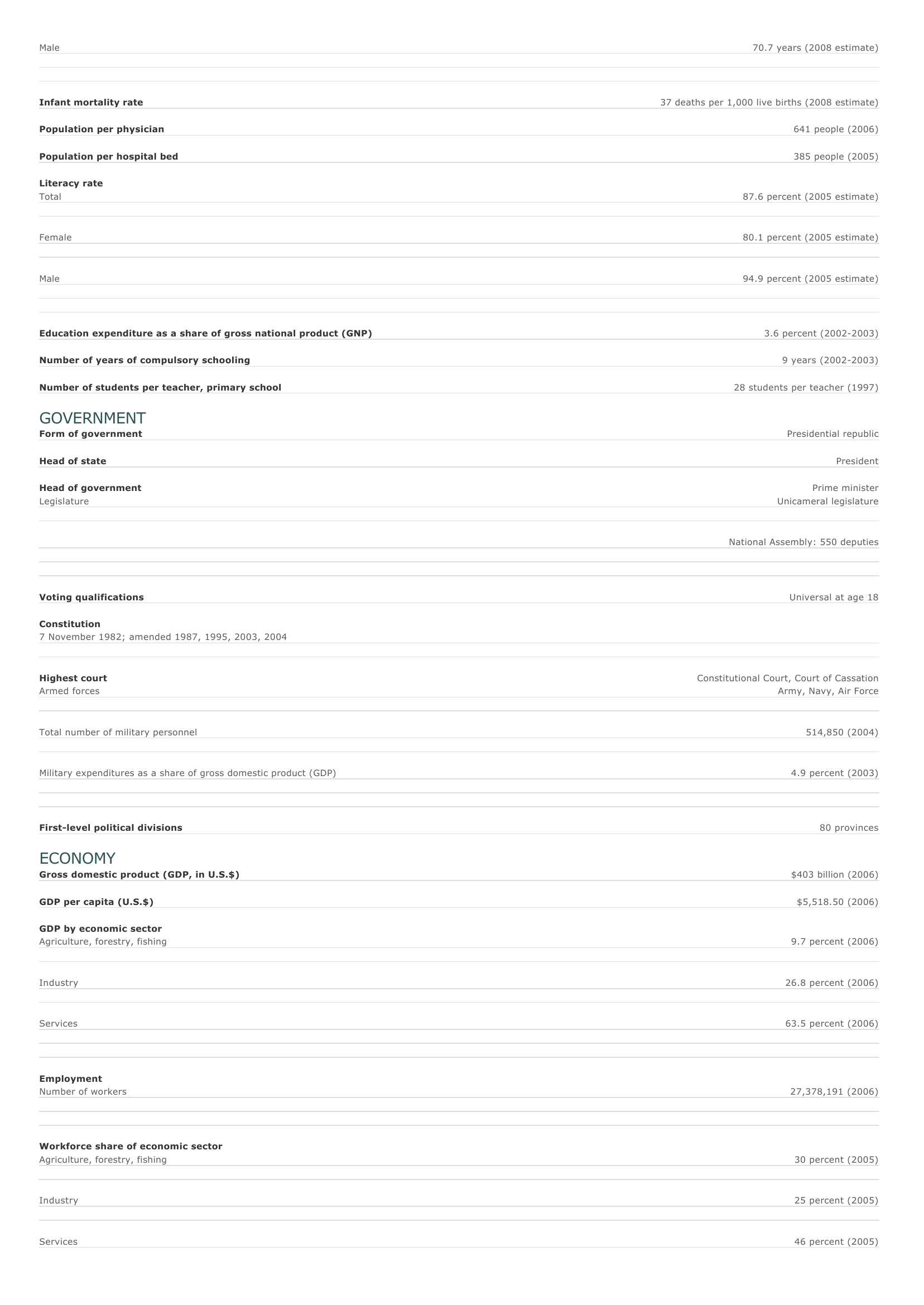Turkey Facts and Figures. BASIC FACTS Official name Capital Area Republic of Turkey Ankara 779,452 sq km 300,948 sq mi PEOPLE Population 71,892,807 (2008 estimate) Population growth Population growth rate 1.01 percent (2008 estimate) Projected population in 2025 82,204,623 (2025 estimate) Projected population in 2050 86,473,786 (2050 estimate) Population density 93 persons per sq km (2008 estimate) 242 persons per sq mi (2008 estimate) Urban/rural distribution Share urban 67 percent (2005 estimate) Share rural 33 percent (2005 estimate) Largest cities, with population ? stanbul A nkara 11,174,257 (2007 estimate) 3,428,000 (2003 estimate) ? zmir 2,409,000 (2000) Bursa 459,877 (2007 estimate) Adana 395,388 (2007 estimate) Ethnic groups Turkish 80 percent Kurdish 17 percent O ther 3 percent Languages Turkish (official), Kurdish, Arabic Religious affiliations Muslim (mostly Sunni Muslim) Nonreligious and others 99 percent 1 percent HEALTH AND EDUCATION Life expectancy Total 73.1 years (2008 estimate) Female 75.7 years (2008 estimate) Male Infant mortality rate 70.7 years (2008 estimate) 37 deaths per 1,000 live births (2008 estimate) Population per physician 641 people (2006) Population per hospital bed 385 people (2005) Literacy rate Total 87.6 percent (2005 estimate) Female 80.1 percent (2005 estimate) Male 94.9 percent (2005 estimate) Education expenditure as a share of gross national product (GNP) Number of years of compulsory schooling Number of students per teacher, primary school 3.6 percent (2002-2003) 9 years (2002-2003) 28 students per teacher (1997) GOVERNMENT Form of government Head of state Head of government Legislature Presidential republic President Prime minister Unicameral legislature National Assembly: 550 deputies Voting qualifications Universal at age 18 Constitution 7 November 1982; amended 1987, 1995, 2003, 2004 Highest court Armed forces Total number of military personnel Military expenditures as a share of gross domestic product (GDP) First-level political divisions Constitutional Court, Court of Cassation Army, Navy, Air Force 514,850 (2004) 4.9 percent (2003) 80 provinces ECONOMY Gross domestic product (GDP, in U.S.$) GDP per capita (U.S.$) GDP by economic sector Agriculture, forestry, fishing $403 billion (2006) $5,518.50 (2006) 9.7 percent (2006) I ndustry 26.8 percent (2006) Services 63.5 percent (2006) Employment Number of workers 27,378,191 (2006) Workforce share of economic sector Agriculture, forestry, fishing 30 percent (2005) I ndustry 25 percent (2005) Services 46 percent (2005) Unemployment rate 10.3 percent (2005) National budget (U.S.$) Total revenue $132,712 million (2006) Total expenditure $117,603 million (2006) Monetary unit 1 New Turkish lira (YTL), consisting of 100 new kurus Agriculture Cotton, tobacco, wheat, fruit, nuts, barley, sunflower and other oilseeds, maize, sugar beets, potatoes, tea, olives, livestock Mining Chromium, boron, copper, petroleum, natural gas, lignite, bauxite, iron ore, manganese, antimony, lead, zinc, sulfur Manufacturing Textiles, food products, refined petroleum, iron and steel, industrial chemicals Major exports Textiles, iron and steel, dried fruits, leather garments, tobacco, petroleum products Major imports Machinery, crude petroleum, transportation vehicles, iron and steel, chemical products Major trade partners for exports Germany, United States, Italy, United Kingdom, and France Major trade partners for imports Germany, Italy, Russia, United States, and France ENERGY, COMMUNICATIONS, AND TRANSPORTATION Electricity production Electricity from thermal sources 73.68 percent (2003 estimate) Electricity from hydroelectric sources 26.17 percent (2003 estimate) Electricity from nuclear sources Electricity from geothermal, solar, and wind sources Number of radios per 1,000 people 0 percent (2003 estimate) 0.16 percent (2003 estimate) 562 (2000 estimate) Number of telephones per 1,000 people 263 (2005) Number of televisions per 1,000 people 443 (2000 estimate) Number of Internet hosts per 10,000 people 53 (2003) Daily newspaper circulation per 1,000 people 111 (1996) Number of motor vehicles per 1,000 people 108 (2004) Paved road as a share of total roads 42 percent (2002) SOURCES Basic Facts and People sections Area data are from the statistical bureaus of individual countries. Population, population growth rate, and population projections are from the United States Census Bureau, International Programs Center, International Data Base (IDB) (www.census.gov). Urban and rural population data are from the Food and Agriculture Organization (FAO) of the United Nations (UN), FAOSTAT database (www.fao.org). Largest cities population data and political divisions data are from the statistical bureaus of individual countries. Ethnic divisions and religion data are largely from the latest Central Intelligence Agency (CIA) World Factbook and from various country censuses and reports. Language data are largely from the Ethnologue, Languages of the World, Summer Institute of Linguistics International (www.sil.org). Health and Education section Life expectancy and infant mortality data are from the United States Census Bureau, International Programs Center, International database (IDB) (www.census.gov). Population per physician and population per hospital bed data are from the World Health Organization (WHO) (www.who.int). Education data are from the United Nations Educational, Scientific and Cultural Organization (UNESCO) database (www.unesco.org). Government section Government, independence, legislature, constitution, highest court, and voting qualifications data are largely from various government Web sites, the latest Europa World Yearbook, and the latest Central Intelligence Agency (CIA) World Factbook. The armed forces data is from Military Balance. Economy section Gross domestic product (GDP), GDP per capita, GDP by economic sectors, employment, and national budget data are from the World Bank database (www.worldbank.org). Monetary unit, agriculture, mining, manufacturing, exports, imports, and major trade partner information is from the statistical bureaus of individual countries, latest Europa World Yearbook, and various United Nations and International Monetary Fund (IMF) publications. Energy, Communication, and Transportation section Electricity information is from the Energy Information Administration (EIA) database (www.eia.doe.gov). Radio, telephone, television, and newspaper information is from the United Nations Educational, Scientific and Cultural Organization (UNESCO) database (www.unesco.org). Internet hosts, motor vehicles, and road data are from the World Bank database (www.worldbank.org). Note Figures may not total 100 percent due to rounding. Microsoft ® Encarta ® 2009. © 1993-2008 Microsoft Corporation. All rights reserved.






